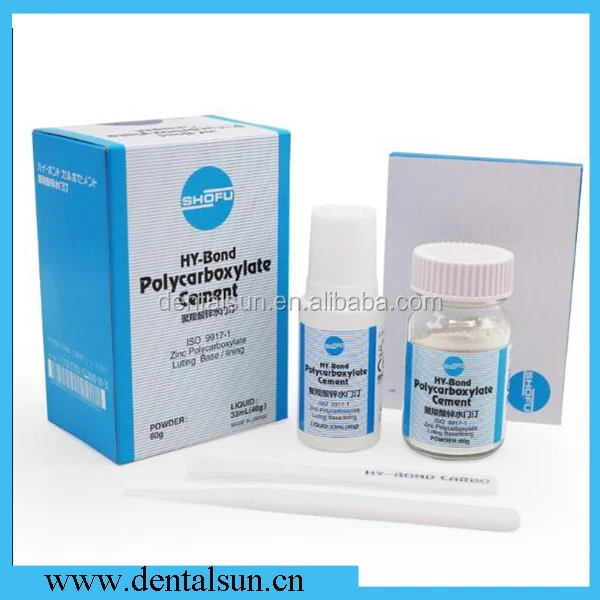
Common resin cements utilised for bonded amalgams are RMGIC and dual-cure resin based composite. The powder is composed of mainly zinc oxide, magnesium oxide, bismuth, and aluminum oxide. A wide variety of zinc polycarboxylate options are available to you, such as coating auxiliary agents, petroleum additives, and water treatment chemicals. In addition to the excellent biocompatibility inherent in such cements it has enhanced mechanical strength and erosion resistance due to the addition of sodium fluoride.
Polycarboxylate Cement System - Base Safety Data Sheet. If you continue browsing the site, you agree to the use of cookies on this website. The solid ingredients are mixed at the time of application with an aqueous solution of the polycarboxylate polymer. POLYCARBOXYLATE CEMENT Warning:! Avoid contact with eyes and skin.
In case of contact, flush with copious amounts of water for at least minutes. Seek immediate medical attention. Mixing Using a suitable spatula, incorporate all of the powder rapidly into the liquid. It has the ability to bond to both enamel and dentine. Very little pulpal irritation is seen with its use due to the large size of the polyacrylic acid molecule.

Fill Your Cart With Color today! These chemicals are available in a wide selection of volumes and sizes, literally from Drops to DrumsTM, to take you from product evaluation through production. HY-Bond Zinc Phosphate Cement;. Developed with Shofu’s exclusive tannin fluoride additive. Zinc phosphate, zinc polycarboxylate and zinc oxide eugenol cements have the same structure (Figure 1).
This is because these products have the same base ( zinc oxide) and the different cements are produced by the reaction of this base with different acids. Start studying Dental Materials - cements. What is zinc polycarboxylate used for?
Learn vocabulary, terms, and more with flashcards, games, and other study tools. Both these have been used in dentistry for a long time. They have an acid component that tends to etch the tooth, demineralizing the dentin, although not in an even way. Cavity lining for pulp protection, good bonding and flow properties.
It was also found to have low irritancy towards oral tissues. A material that is comparable to ZOP is zinc polycarboxylate (ZPC). Zinc polycarboxylate cement for fixing of crowns, bridges and inlays, cavity lining for pulp protection, good bonding and flow properties.

The important difference is the liquid component. The liquid in ZPC is polyacrylic aci which is quite viscous. There are 1polycarboxylate cement suppliers, mainly located in Asia. The top supplying countries are China (Mainland), Turkey, and India, which supply , , and of polycarboxylate cement respectively. There is a wide range of luting agents available in the market including GIC, zinc phosphate cements, zinc polycarboxylate and resin cements (dual cure auto cured and photo-polymerized resin cements).
Mathewson were zinc phos-phate and polycarboxylate. An in vitro study was conducted to compare the retentive strengths of zinc phosphate, polycarboxylate and glass ionomer cements using Instron universal testing machine. They are currently the most widely used luting agents today. The relatively high creep of zinc polycarboxylate cements may not be acceptable for certain fixed orthodontic appliances or for large (long-span) bridge structures.
All “conventional” cements have similar low fracture toughness. The main difference between the is the liquid component. With ZPC, the liquid is polyacrylic acid.
Although it may be difficult to mix and handle, ZPC is adherent to tooth structure. Compared with zinc -phosphate cement, polycarboxylate cement has. The major disadvantage of zinc phosphate used to cement crowns is the The principal. Two examples of zinc polycarboxylate dental cement were studie one of which was prepared from an aqueous solution of poly (acrylic acid) together with the zinc oxide powder, the other being prepared by adding water to a mixture of dried polyacid and zinc oxide powder. The set cement consists of residual zinc oxide bonded together by.
This pow-der, which is available in one distinctive shade, is mixed with demineralized water only. This product is for professional use only. Temporary filling , Permanent and semi permanent cementation and Lining under amalgam and composite fillings.
Double click on above image to view full picture. This cement is formed when zinc oxide powder is mixed with polyacrylic acid. When zinc oxide and polyacrylic acid are mixe hydrated protons formed from ionization of the acid attack the zinc and magnesium powder particles.
This causes the release of zinc and magnesium cations which form polycarboxylates that crosslink the polymer chains. The cements available for use in various provisional procedures include zinc oxide eugenol (including reinforced), zinc oxide non-eugenol, resin temporary cement, glass ionomer temporization cement, and polycarboxylate cement. As with ZOP, the powder is composed of zinc oxide and magnesium oxide.
No comments:
Post a Comment
Note: Only a member of this blog may post a comment.